Sources
- ↑ "bone" (Swadesh list no. 65) at Turkic Database compiled by Christopher A. Straughn, PhD, MSLIS
- ↑ Potapov L.P., "Ethnic composition and origin of Altaians. Historical ethnographical essay", p. 22 on
Seok (from a Siberian Turkic word meaning "bone" [1] ) is an international term for a clan used in Eurasia from the Middle Asia to the Far East. Seok is usually a distinct member of the community; the name implies that its size is smaller than that of a distinct tribe. It is a term for a clan among the Turkic-speaking people in Siberia, Central Asia, and the Far East.
The term "Seok" designates a distinct ethnical, geographical, or occupational group distinguishable within a community, usually an extract from a separate distinct tribe. Smaller seoks tend to intermarry and dissolve after a few centuries, or a couple of dozens generations, gaining new ethnic names, but still carrying some elements and proscriptions of their parent seok, like the incest restrictions. Larger seoks tend to survive for millennia, carrying their tribal identification and a system of blood and political alliances and enmities. In the Turkic societies, the integrity and longevity of the seoks was based on the blood relations, fed by a permanent alliance of conjugal tribes. After a separation with a conjugal partner caused by a forced migration, which amounts to a communal divorce, a seok would seek and establish a new permanent conjugal partnership, eventually obtaining new cultural, genetical, and linguistical traits, which in ethnological terms constitutes a transition to a new ethnicity. [2]

The Mongols are an East Asian ethnic group native to Mongolia, Inner Mongolia in China and the Buryatia Republic of the Russian Federation. The Mongols are the principal member of the large family of Mongolic peoples. The Oirats in Western Mongolia as well as the Buryats and Kalmyks of Russia are classified either as distinct ethno-linguistic groups or subgroups of Mongols.

The Bulgars were Turkic semi-nomadic warrior tribes that flourished in the Pontic–Caspian steppe and the Volga region during the 7th century. They became known as nomadic equestrians in the Volga-Ural region, but some researchers say that their ethnic roots can be traced to Central Asia. During their westward migration across the Eurasian steppe, the Bulgar tribes absorbed other tribal groups and cultural influences in a process of ethnogenesis, including Iranian, Finnic and Hunnic tribes. Modern genetic research on Central Asian Turkic people and ethnic groups related to the Bulgars points to an affiliation with Western Eurasian populations. The Bulgars spoke a Turkic language, i.e. Bulgar language of Oghuric branch. They preserved the military titles, organization and customs of Eurasian steppes, as well as pagan shamanism and belief in the sky deity Tangra.

The Turkic peoples are a collection of diverse ethnic groups of Central, East, North and West Asia as well as parts of Europe, who speak Turkic languages.
The Five Barbarians, or Wu Hu, is a Chinese historical exonym for five ancient non-Han peoples who immigrated to northern China in the Eastern Han dynasty, and then overthrew the Western Jin dynasty and established their own kingdoms in the 4th–5th centuries. The peoples categorized as the Five Barbarians were the Xiongnu, Jie, Xianbei, Di, and Qiang. Of these five tribal ethnic groups, the Xiongnu and Xianbei were nomadic peoples from the northern steppes. The ethnic identity of the Xiongnu is uncertain, but the Xianbei appear to have been Mongolic. The Jie, another pastoral people, may have been a branch of the Xiongnu, who may have been Yeniseian. The Di and Qiang were from the highlands of western China. The Qiang were predominantly herdsmen and spoke Sino-Tibetan (Tibeto-Burman) languages, while the Di were farmers who may have spoken a Sino-Tibetan or Turkic language.

The Oguz or Ghuzz Turks were a western Turkic people that spoke the Oghuz branch of the Turkic language family. In the 8th century, they formed a tribal confederation conventionally named the Oghuz Yabgu State in Central Asia. The name Oghuz is a Common Turkic word for "tribe". Byzantine sources call the Oghuz the Uzes. By the 10th century, Islamic sources were calling them Muslim Turkmens, as opposed to Tengrist or Buddhist. By the 12th century, this term had passed into Byzantine usage and the Oghuzes were overwhelmingly Muslim. The term "Oghuz" was gradually supplanted among the Turks themselves by the terms Turkmen and Turcoman, from the mid-10th century on, a process which was completed by the beginning of the 13th century.

The Pechenegs or Patzinaks were a semi-nomadic Turkic ethnic people from Central Asia speaking the Pecheneg language which belonged to the Oghuz branch of the Turkic language family.

Turkmens, sometimes referred to as "Turkmen Turks", are a Turkic ethnic group native to Central Asia, living mainly in Turkmenistan, northern and northeastern regions of Iran and north-western Afghanistan. Sizeable groups of Turkmens are found also in Uzbekistan, Kazakhstan and the North Caucasus. They speak the Turkmen language, which is classified as a part of the Eastern Oghuz branch of the Turkic languages. Examples of other Oghuz languages are Turkish, Azerbaijani, Qashqai, Gagauz, Khorasani and Salar.
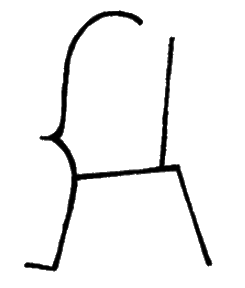
The Ashina, were a tribe and the ruling dynasty of the Göktürks. This clan rose to prominence in the mid-6th century when the leader, Bumin Qaghan, revolted against the Rouran Khaganate. The two main branches of the family, one descended from Bumin and the other from his brother Istämi, ruled over the eastern and western parts of the Göktürk confederation, respectively.
The Karluks were a prominent nomadic Turkic tribal confederacy residing in the regions of Kara-Irtysh and the Tarbagatai Mountains west of the Altay Mountains in Central Asia. They were also known as the Géluólù. Karluks gave their name to the distinct Karluk group of the Turkic languages, which also includes the Uyghur, Uzbek and Ili Turki languages.
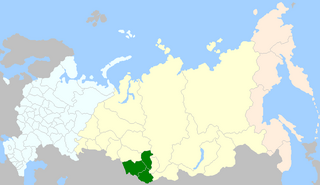
The Kumandins are a Turkic indigenous people of Siberia. They reside mainly in the Altai Krai and Altai Republic of the Russian Federation. They speak the Northern Altai Kumandin language.
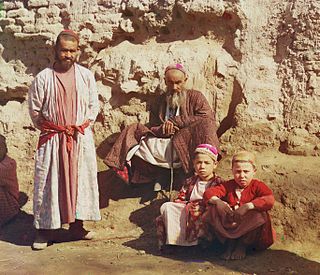
Sart is a name for the settled inhabitants of Central Asia which has had shifting meanings over the centuries. Sarts, known sometimes as Ak-Sart in ancient times, did not have any particular ethnic identification, and were usually town-dwellers.

The Altai people, also the Altaians, are a Turkic ethnic group of indigenous peoples of Siberia mainly living in the Altai Republic, Russia. Several thousand of the Altaians also live in Mongolia and China but are officially unrecognized as a distinct group and listed under the name "oirots" as a part of the Mongols. For alternative ethnonyms see also Tele, Black Tatar and Oirats. During the Northern Yuan Dynasty of Mongolia, they were ruled in the administrative area known as Telengid Province.
Turkic migration refers to the spread of Turkic tribes and Turkic languages across Eurasia and between the 6th and 11th centuries. In the 6th century, the Göktürks overthrew the Rouran Khaganate in what is now Mongolia and expanded in all directions, spreading Turkic culture throughout the Eurasian steppes. Although Göktürk empires came to an end in the 8th century, they were succeeded by numerous Turkic empires such as the Uyghur Khaganate, Kara-Khanid Khanate, Khazars, and the Cumans. Some Turks eventually settled down into a sedentary society such as the Qocho and Ganzhou Uyghurs. The Seljuq dynasty settled in Anatolia starting in the 11th century, resulting in permanent Turkic settlement and presence there. Modern nations with large Turkic populations include Kyrgyzstan, Turkmenistan, Turkey, Azerbaijan, Uzbekistan and Kazakhstan, and Turkic populations also exist within other nations, such as Chuvashia, Bashkortostan, Tatarstan, the Crimean Tatars, the Kazakhs in Mongolia, the Uyghurs in China, and the Sakha Republic in Siberia.

The Toquz Oghuz was a political alliance of nine Turkic-speaking Tiele tribes in Inner Asia, during the early Middle Ages. Toquz Oghuz was consolidated and subordinated within the First Turkic Kaganate (552–743) and remained as a nine-tribe alliance after the Khaganate fragmented.
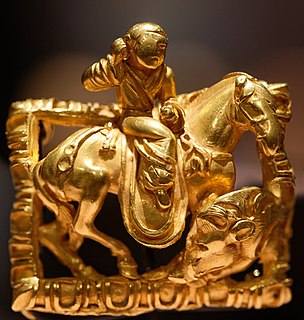
Nomadic empires, sometimes also called steppe empires, Central or Inner Asian empires, were the empires erected by the bow-wielding, horse-riding, nomadic people in the Eurasian Steppe, from classical antiquity (Scythia) to the early modern era (Dzungars). They are the most prominent example of non-sedentary polities.

The Oghuz Yabgu State was a Turkic state, founded by Oghuz Turks in 766, located geographically in an area between the coasts of the Caspian and Aral Seas. Oghuz tribes occupied a vast territory in Kazakhstan along the Irgiz, Yaik, Emba, and Uil rivers, the Aral Sea area, the Syr Darya valley, the foothills of the Karatau Mountains in Tien-Shan, and the Chui River valley. The Oghuz political association developed in the 9th and 10th centuries in the basin of the middle and lower course of the Syr Darya and adjoining the modern western Kazakhstan steppes.

Shad was a state office in the early Central Asian Turkic states, roughly equivalent to governor. "Shad" could only be an appointee over a vassal tribe, where he represented interests of the preeminent Kagan. The name of this tribe was included in his title. For example, Tardu-shad could only be a Shad over Tardu tribe. The title carried autonomy in different degrees, and its links with the central authority of kagan varied from economical and political subordination to superficial political deference. The title Shad is borrowed from an Iranian source.
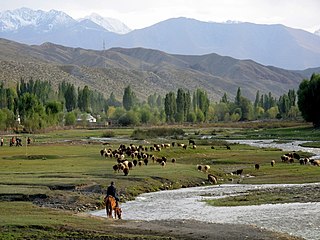
The Tiele, also transliterated as Dili, Chile, Zhile, Tele, also named Gaoche or Gaoju, were a tribal confederation of Turkic ethnic origins living to the north of China and in Central Asia, emerging after the disintegration of the confederacy of the Xiongnu. Chinese sources associate them with the earlier Dingling.
An orda or horde was a historical sociopolitical and military structure found on the Eurasian Steppe, usually associated with the Turkic and Mongol peoples. This form of entity can be seen as the regional equivalent of a clan or a tribe. Some successful ordas gave rise to khanates.
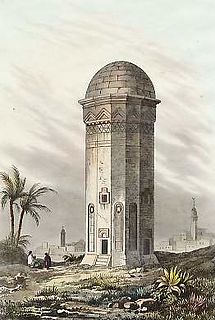
Turkoman, also called Turcoman and Turkman, is a term that was widely used during the Middle Ages for the people of Oghuz Turkic origin. Oghuz Turks were a western Turkic people that, in the 8th century A.D, formed a tribal confederation in an area between the Aral and Caspian seas in Central Asia, and spoke the Oghuz branch of the Turkic language family. According to medieval Islamic authors Al-Biruni and al-Marwazi, the term Turkoman referred to the Oghuz who converted to Islam. There is evidence, however, that non-Oghuz Turks such as Karluks also have been called Turkomans and Turkmens.